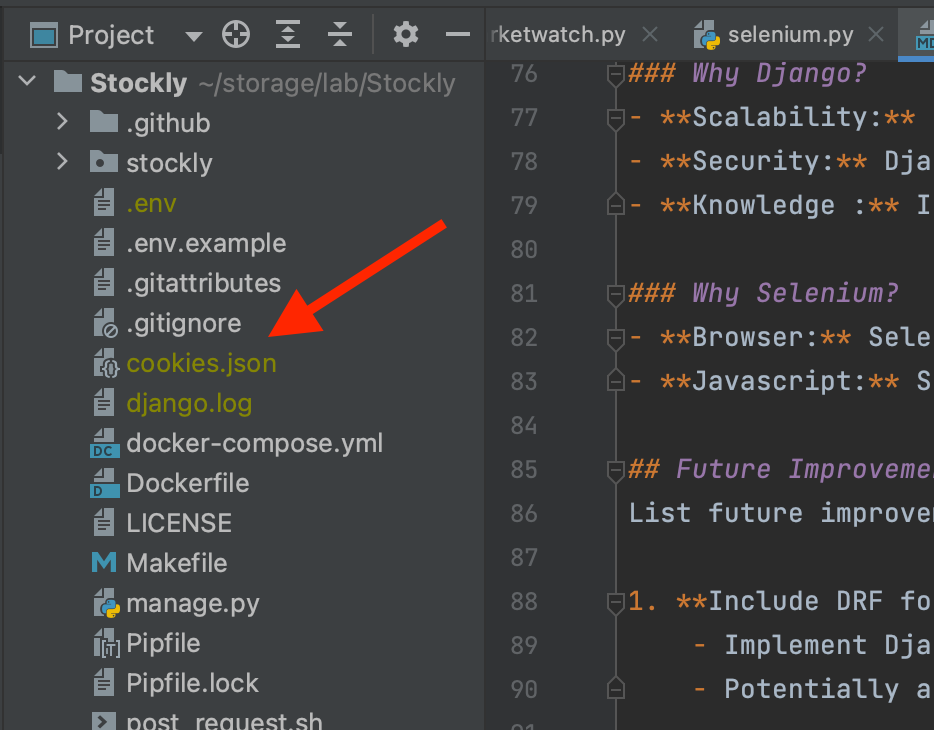API to retrieve and aggregate stock data from external sources and purchase.
- docker & docker-compose
- Clone and Navigate to the project:
git clone git@github.com:kistters/Stockly.git cd Stockly - Environments:
cp .env.example .env # check if you have credential to replace - Build & Run the project:
make start
A step-by-step guide to help you interact and test the Stockly API.
- Ensure the server is running:
Navigate to
http://127.0.0.1:8000/in your web browser. Not Found page expected. - Consulting first stock:
Navigate to
http://127.0.0.1:8000/stock/AMZN/in your web browser or use a tool like Postman. - Make a stock purchase
Open another terminal, then run:
make new-purchased-amount AMOUNT=185.9 # will make a request using curl
- Run Test:
make test - interact with containers:
make backend-bash make redis-cli
With the docker image selenium/standalone-chrome:4.13.0 is possible use VNC to monitor the browser.
- Selenium Grid overview:
Navigate to
http://0.0.0.0:4444/in your web browser. - VNC connection:
Navigate to
http://0.0.0.0:7900/in your web browser. The password is "secret". :D
- Marketwatch CAPTCHA issue:
I was randomly required to solve a CAPTCHA during the Selenium scraper.
After some testing and initial failures, I discovered a cookie within the
.marketwatch.comdomain called 'datadome'. Here’s how to update it:
- Open your usual Chrome browser and navigate to
https://www.marketwatch.com/investing/stock/AAPL. - Open the Developer Tools (F12 or right-click and select "Inspect"), go to the "Application" tab on the left bar, and then search through the cookies under the
https://www.marketwatch.comdomain. - Find the cookie named "datadome" and copy the Cookie Value.
- Go back to the base folder of the repository and locate a file called
cookies.json. - Inside the JSON file, search for the "datadome" entry and replace its value with the one you copied.
- Try
http://127.0.0.1:8000/stock/AMZN/again.
This should help you bypass the CAPTCHA issue.
Explanation of why Django and Selenium were chosen for the project.
- Scalability: Django’s design encourages clean, pragmatic design and rapid development.
- Security: Django includes built-in protection against many common security threats.
- Knowledge : I'm use to Django and love the features.
- Browser: Selenium is a powerful tool for controlling a web browser, in the project case, Chrome.
- Javascript: Scraper on MarketWatch is possible,
requests.getdo not execute javascript.
List future improvements and features you plan to implement.
-
Include DRF for Authentication and API Layer:
- Implement Django Rest Framework (DRF) to provide a robust API layer with token-based authentication.
- Potentially add OAuth or JWT for more secure authentication.
-
Include Logged-in User to StockRecord:
- Modify the StockRecord model to associate each record with the currently logged-in user.
- Update views, serializers, and forms to handle the new relationship.
-
Celery to async tasks:
- Implement Celery to handle long-running tasks to avoid making users wait for actions that consume multiple APIs.
- Improve overall performance by offloading intensive operations to worker processes.
-
Sentry & New Relic Integration:
- ntegrate Sentry for real-time error monitoring and reporting.
- Use New Relic for performance monitoring to gain insights into application performance and identify bottlenecks.

